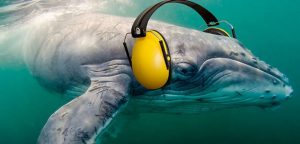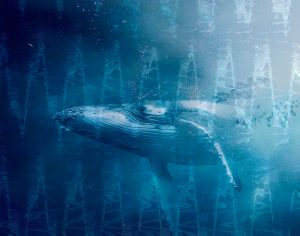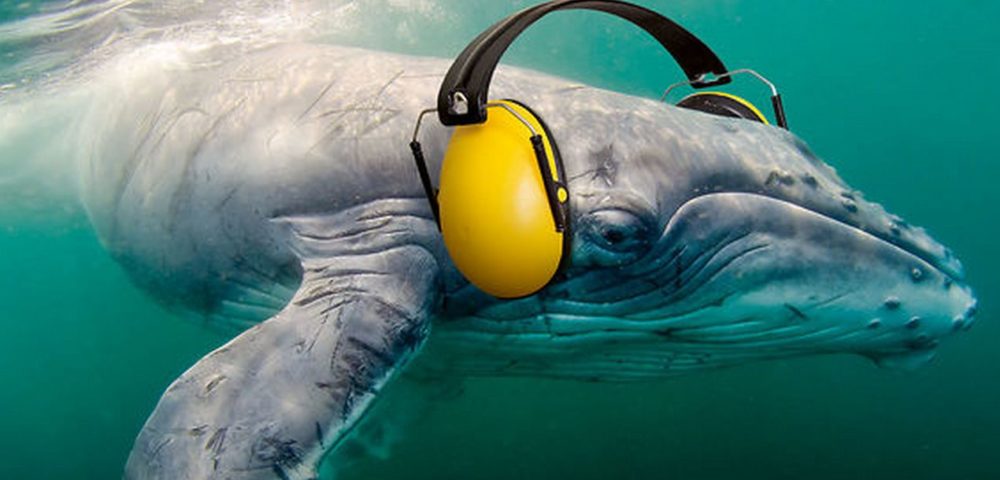
Featured Image Credit: OceanCare, By Eva Gruber
Oceans are full of sound. Waves, earthquakes and calving icebergs all contribute to the underwater soundscape. But so do human activities, and this can be a problem for marine life as it can seriously affect their physiology, behavior, reproduction and even survival. Being able to produce and detect sound in an environment where light penetrates only a few hundred meter is crucial for animals to communicate, feed, avoid predators and navigate vast underwater habitats. Large whales generate low frequency communication calls that can travel thousands of kilometers. While the snapping shrimp, native to the western Atlantic, can produce a loud snapping sound capable of stunning and killing its prey.
The noise generated by humans changes the natural acoustic environment of our oceans and our capacity to produce it is increasing. Noise is often the unintentional byproduct of transport, infrastructure development and industry. Yet noise can also be produced deliberately. Many navies use sonar to detect ships and submarines, while geologists survey the seabed for oil and gas using seismic airguns. The noise produced by an airgun can exceed 200 decibels (louder than a gunshot at a range of one meter).
Sound travels further and four times faster in water than in air (at a speed of almost 1,500 meters per second). The noise produced by humans can therefore spread considerable distances underwater. These sounds can be relatively constant, such as the noise produced by a ship’s engine and propeller, or sudden and acute in the case of naval sonar and seismic airguns.
Can noise kill?
The sound produced by a seismic airgun can cause permanent hearing loss, tissue damage and even death in nearby animals. Evidence for the lethal effects of noise can be hard to document in the open ocean. But seismic surveys have been linked to the mass mortality of squid and zooplankton. In 2017, research revealed that a single air gun caused the death rate of zooplankton to increase from 18% to 40–60% over a 1.2 kilometer stretch of the ocean off the coast of southern Tasmania.
The use of naval sonar has also been associated with the mass stranding of several whale species in the Caribbean, Europe and East Asia. Mass stranding events involve entire pods of animals simultaneously beaching themselves. Examination of the dead whales revealed they had suffered trauma similar to decompression sickness. This was believed to have been caused by sudden changes in their deep diving behavior following exposure to sonar.
Arrested development
Over the past two decades, research has also revealed the widespread impact of chronic noise exposure on animal behavior and physiology. These impacts can extend well beyond the noise source and affect vast areas of the ocean. Laboratory studies on the sea hare – a marine slug – revealed that exposure to boat noise led to a 21% reduction in successful embryo development. Individuals that hatched also suffered a 22% higher death rate than sea hares that were not exposed to boat noise. These findings demonstrate the negative effects that a common source of underwater noise can have on animal development and survival. If these laboratory results can be applied to natural environments then such impacts could threaten entire populations of marine species in particular areas.
Disrupted behavior
Observing the movements, feeding, communication, resting and social interactions of animals provides scientists with a method for exploring the effects of noise. The behavioral impacts of noise on marine mammals are particularly well studied due to conservation concerns and their reliance on sound for communication, foraging and navigation. Many of these species move large distances and long-range communication is crucial for coordinating social interactions and reproduction. But the sounds produced by large marine mammals are of a similar low frequency range to much of the noise produced by humans. The noise produced by ships tends to be below 2 kHz which overlaps with the vocal frequencies produced by many large mammals. Blue whales, for example, produce frequency vocalizations of less than 100 Hz meaning their calls can be lost in the background din.
Shipping noise has led to marine mammals altering their vocalization patterns. This includes making calls longer and more repetitive or waiting until noise levels drop before calling. Research has shown that shipping noise made within 1,200 meters of humpback whales has caused the whales to either reduce or stop their calling in the waters surrounding the remote Ogasawara Islands in Japan. Despite these vocal adaptations, noise can negatively affect animals’ feeding behavior and increase physiological stress. Research found that a reduction in shipping following the 9/11 terrorist attacks led to a six decibel drop in noise levels in the Bay of Fundy on Canada’s Atlantic coast. This coincided with lower levels of physiological stress detected in North Atlantic right whales when researchers measured stress hormones from floating whale faeces.
The COVID-19 lockdowns also led to previously busy waterways being used more frequently by large marine animals. For example, dolphin numbers – including the endangered pink dolphin – increased in the waters around Hong Kong following temporary restrictions on ferry traffic. Noisy oceans are having a profound negative impact on marine life. Taking action to protect and restore natural soundscapes is a key priority for conservation. The good news is that noise is removed from the environment as soon as the sound source is switched off or turned down. Technological developments in ship design, such as reduced propeller cavitation (the formation of air bubbles on the surface of a propeller), have already lowered the noise produced by ships. Small adjustments in speed can also substantially lower engine and propeller noise. Research has found that a 15.6 to 13.8 knot reduction in the average speed of commercial ships can reduce underwater noise pollution by more than 50%. But global awareness of the impact of noise on ocean health needs improving and policies aimed at managing sound and implementing technological solutions must be more rigorous. These are readily available solutions that promise a brighter – and quieter – future for our oceans.
Reference: Graeme Shannon & marinetechnologynews.com
Addressing underwater noise from ships – draft revised guidelines agreed by IMO
Draft revised Guidelines for the reduction of underwater noise from commercial shipping to address adverse impacts on marine life have been agreed by the IMO Sub-Committee on Ship Design and Construction (SDC 9), which met 23-27 January.
The draft guidelines recognize that commercial shipping is one of the main contributors to underwater radiated noise (URN) which has adverse effects on critical life functions for a wide range of marine life, including marine mammals, fish and invertebrate species, upon which many coastal Indigenous communities depend for their food, livelihoods and cultures.
The draft revised guidelines provide an overview of approaches applicable to designers, shipbuilders and ship operators to reduce the underwater radiated noise of any given ship. They are intended to assist relevant stakeholders in establishing mechanisms and programmes through which noise reduction efforts can be realized.
The draft guidelines revise the previous guidelines (issued in 2014). They include updated technical knowledge, including reference to international measurement standards, recommendations and classification society rules. They also provide sample templates to assist shipowners with the development of an underwater radiated noise management plan.
The draft guidelines will now be submitted to the Marine Environment Protection Committee (MEPC 80), which meets from 3-7 July 2023, for approval.
The draft guidelines were developed by a correspondence group with further work completed by a working group which met during the Sub-Committee session.
The correspondence group was re-established, to report back to SDC 10 in January 2024, to address the remaining work under the agenda item. It was, in particular, tasked with revising a flowchart on the URN Noise Management Planning process to reflect the Revised Guidelines, and the underwater noise management plan included in appendix 3, to be used as a tool for raising awareness. The group will also finalize and prioritize the provisional list of suggested next steps to further prevent and reduce underwater radiated noise from ships.
The Sub-Committee agreed a work plan which envisages, among other things, identifying ways to implement the Revised Guidelines and increase awareness and uptake; organizing an expert workshop on potential co-benefits and trade-offs that may exist between the reduction of underwater radiated noise from ships and energy efficiency; and developing a plan of action for further work.
Underwater noise in Inuit Nunaat and the Arctic
The revised draft guidelines include reference to Inuit Nuaat, saying that, in Inuit Nunaat, a number of characteristics of the region and the activities within could increase the impacts from underwater radiated noise. This includes potential for icebreaking activities, presence of noise-sensitive species, and potential interference with indigenous hunting rights. Additional efforts to decrease impacts on marine wildlife are advisable for ships that operate in these areas, including particular attention to reducing the noise impact from icebreaking and implementation of operational approaches and monitoring.
In addition, the working group developed separate draft guidelines for underwater radiated noise reduction in Inuit Nunaat and the Arctic, with a view to being utilized in the future by interested parties.
These draft guidelines recognize that Inuit Nunaat is a unique environment and adverse impacts to marine wildlife in this area from shipping noise may be significantly increased as a result. Sound levels throughout Inuit Nunaat are lower than elsewhere, making it more vulnerable to increases from industrial activity.

GloNoise project
IMO’s Department of Partnerships and Projects (DPP) later this year will commence a two-year GEF-UNDP-IMO project called the Global Partnership for Mitigation of Underwater Noise from Shipping (GloNoise Partnership), which is aligned with the current work on the review of the Guidelines for the reduction of underwater noise (MEPC.1/Circ.833) (pending approval by MEPC 80, these will then become the Revised Guidelines) and to consider next steps.
The GloNoise Partnership will establish a global stakeholders’ partnership in order to address the major environmental issue of underwater noise from shipping. The partnership will include a strong developing countries’ element as well as public-private engagement. The specific objective of the GloNoise Partnership is to assist developing countries and regions to raise awareness, to build capacity and to collect information to assist the policy dialogue on anthropogenic underwater noise from shipping. To support this process, data and analysis tools and capacity building materials will be developed, rolled out and implemented globally and in the participating countries.
Read more on ship noise here.
Full summary SDC 9 will be available here.
Reference: IMO

